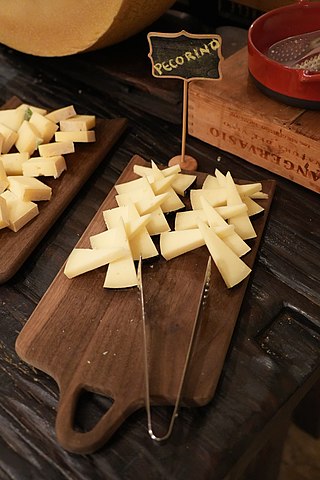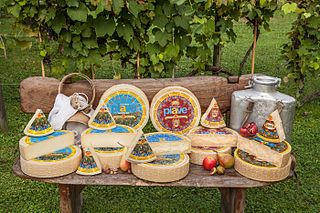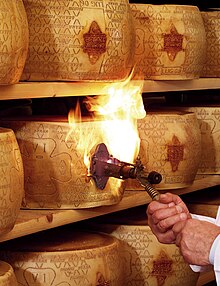
Mozzarella is a semi-soft non-aged cheese prepared by the pasta filata ('stretched-curd') method with origins from southern Italy.

Pecorino is an Italian hard cheese produced from sheep's milk. The name pecorino derives from pecora, which means 'sheep' in Italian.

Parmesan is an Italian hard, granular cheese produced from cow's milk and aged at least 12 months or, outside the European Union, a locally produced imitation.

Gorgonzola is a veined protected designation of origin (PDO) Italian blue cheese, made from unskimmed cow's milk. It can be buttery or firm, crumbly and quite salty, with a "bite" from its blue veining. Outside the EU and the countries recognizing the geographical origin protection, the name "Gorgonzola" can legally be used for similar cheeses, with only the full Italian name unambiguously referring to PDO Gorgonzola. It is a famously pungent cheese.

Goat cheese, goat's cheese or chèvre is cheese made from goat's milk. Goats were among the first animals to be domesticated for producing food. Goat cheese is made around the world with a variety of recipes, giving many different styles of cheeses, from fresh and soft to aged and hard.

Asiago is a cow's milk cheese, first produced in Asiago in Italy, that can assume different textures according to its aging, from smooth for the fresh Asiago to a crumbly texture for the aged cheese. The aged cheese is often grated in salads, soups, pastas, and sauces while the fresh Asiago is sliced to prepare panini or sandwiches; it can also be melted on a variety of dishes and cantaloupe. It is classified as a Swiss-type or Alpine cheese.

Cheesemaking is the craft of making cheese. The production of cheese, like many other food preservation processes, allows the nutritional and economic value of a food material, in this case milk, to be preserved in concentrated form. Cheesemaking allows the production of the cheese with diverse flavors and consistencies.

Sirene, also known as "white brine sirene", is a type of brined cheese originating from Bulgaria. It is made of the milk of goats, sheep, cows, buffalo or a mixture thereof. It is slightly crumbly, with at least 46–48% of dry matter containing 44–48% of fat. It is commonly produced in blocks, and has a slightly grainy texture. It is used as a table cheese, in salads, and in baking.

Piave is an Italian cow's milk cheese that is named after the Piave river. As Piave has a protected designation of origin (DOP), the only "official" Piave is produced in the Dolomites area, province of Belluno, in the northernmost tip of the Veneto region.

Pecorino sardo is a firm cheese from the Italian island of Sardinia, made from sheep's milk, specifically from the milk of the local Sardinian breed. It was awarded denominazione d'origine status in 1991 and granted protected designation of origin protection in 1996, the year in which this European Union certification scheme was introduced.
White cheese includes a wide variety of cheese types discovered in different regions, sharing the sole common characteristic of their white hue. The specific type of white cheese can vary significantly depending on the geographical location.
Grana is a type of hard, mature cheese from Italy with a granular texture, often used for grating. Grana cheeses are typically made in the form of large wheels. The structure is often described as crystalline, and the wheels are divided by being split with a fairly blunt almond-shaped knife designed for the purpose, rather than being sliced, cut or sawn. Within the European Union the term grana is legally protected by Grana Padano protected designation of origin (PDO); only Grana Padano may be sold using the term in EU countries.

There are many different types of cheese. Cheeses can be grouped or classified according to criteria such as length of fermentation, texture, methods of production, fat content, animal milk, and country or region of origin. The method most commonly and traditionally used is based on moisture content, which is then further narrowed down by fat content and curing or ripening methods. The criteria may either be used singly or in combination, with no single method being universally used.

Pecorino toscano is a firm-textured ewe's milk cheese produced in Tuscany. Since 1996 it has enjoyed protected designation of origin (PDO) status.

Cheese crystals are whitish, semi-solid to solid, slightly crunchy to gritty crystalline spots, granules, and aggregates that can form on the surface and inside of cheese. Cheese crystals are characteristic of many long-aged hard cheeses.

Swiss-type cheeses, also known as Alpine cheeses, are a group of hard or semi-hard cheeses with a distinct character, whose origins lie in the Alps of Europe, although they are now eaten and imitated in most cheesemaking parts of the world. Their distinct character arose from the requirements of cheese made in the summer on high Alpine grasslands, and then transported with the cows down to the valleys in the winter, in the historic culture of Alpine transhumance. Traditionally the cheeses were made in large rounds or "wheels" with a hard rind, and were robust enough for both keeping and transporting.

Quartirolo Lombardo is a soft cheese made with cow's milk, which has a Protected designation of origin (PDO) status.
















